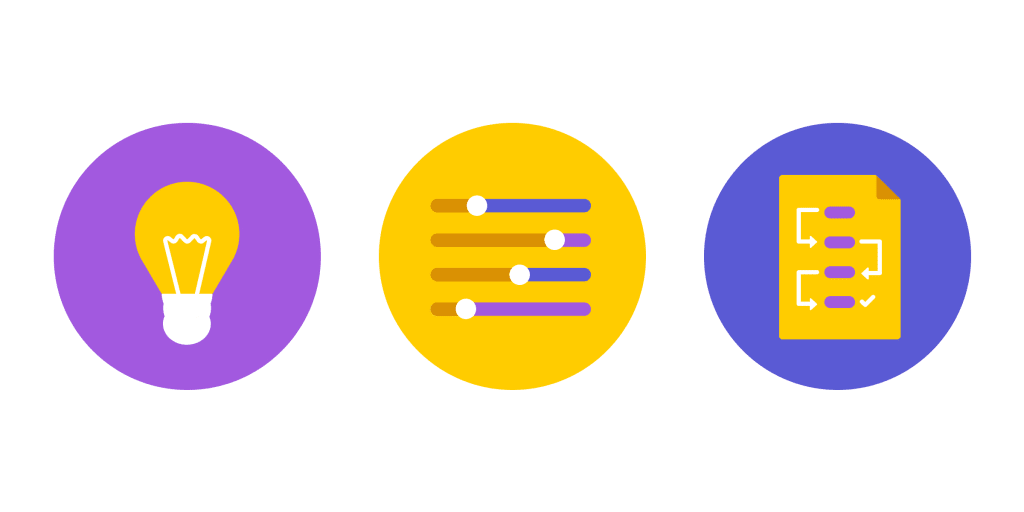No matter the size of the project you’re working on, you have to account for every resource ahead of time, from people and tools to time and budget. But resource allocation goes beyond making a list of available assets. It requires a clear understanding of each task, the effort involved, and how your resources overlap or stretch across teams, and that’s a lot to manage.
This article will explain what resource planning is, why it’s important, the 5 stages you need to include in resource planning, and how you can use AI-powered software like monday work management to effectively allocate and manage resources.
Get startedWhat is resource planning?
Resource planning is the process of identifying, organizing, and managing the resources needed to complete a project successfully. It ensures teams have the right people, tools, time, and budget in place to complete tasks on time and within scope.
Resources can include any or all of the following:
- Team members and their skills
- Project budgets
- Software, tools, and equipment
- Locations, offices, or facilities
- Time and schedules
Resource planning enables project managers to utilize and track all of the assets they have to work with and plan to acquire those that are missing ahead of time.
What’s the difference between resource planning and resource allocation?
Whereas resource planning is the broader, strategic process of identifying, organizing, and managing the resources a project needs, resource allocation is a tactical step within that process. Resource allocation is the actual act of assigning specific resources (like people or tools) to particular tasks or projects.
Need an easy way to allocate assets? Check out our resource allocation template.
Why resource planning is important: 5 key benefits
Effective project resource planning is a critical step in every manager’s project plan. It ensures resource capacity planning is being accurately tracked and managed so that your team can strategically avoid project delays and roadblocks in the future. Let’s look at some reasons why accurate resource allocation is beneficial.
1. Manage project costs effectively
Over-resourced projects eat up time and money, but being under-resourced also leads to missed milestones and disappointed stakeholders. Project resource management helps your team make sure your project has the right resources available at the right time so that you can stick to a budget without going over or under.
2. Increase team productivity
According to Qualtrics XM’s 2025 Global Employee Experience Trends report, 38% of employees feel pressure to increase productivity. When project requirements are aligned with your workforce’s capacity and other resources you need, like software, timelines, and physical space, each employee feels like they have what they need to work more productively.
3. Deliver projects on time
With proper resource allocation, it’s easier to outline project timelines and plan for deliverables. When resources are well-timed, projects progress a lot more smoothly, helping teams avoid delays and roadblocks.
4. Prevent employee burnout
Resource allocation helps managers understand each employee’s workload, talents, capabilities, and how they’ll contribute to a project’s goals. When your team is well-balanced and members have access to the resources they need, employees are less likely to feel strained by workloads and, eventually, burned out.
5. Improve project documentation
Resource planning ensures that your project is well-documented. If your project fails due to a lack of resources, you should be able to demonstrate to stakeholders that you did your best with the resource capacity you were given. This ensures appropriate business accountability, and learning from this experience leads to better resource planning for the next big project.
How to plan your resources in 5 steps
No two organizations are identical, and so the steps you’ve got to take to efficiently plan your resources can differ from one business to another. Still, there are core stages of resource or capacity planning that apply to almost any organization.
Step 1: Define the project scope
Before even touching your resources, you need to have a clear picture of the project at hand. Begin by outlining the scope of your project and its goals, including:
- Deadlines, deliverables, and milestones
- Potential project risks
- Constraints and limitations that could impact resources
From here, you’ll want to start breaking down your project into smaller tasks to make it easier to determine resources for each one. Defining your project scope from the start will make it easier to plan resource requirements ahead of time and get all your team members on the same page.
Step 2: Assess current resources
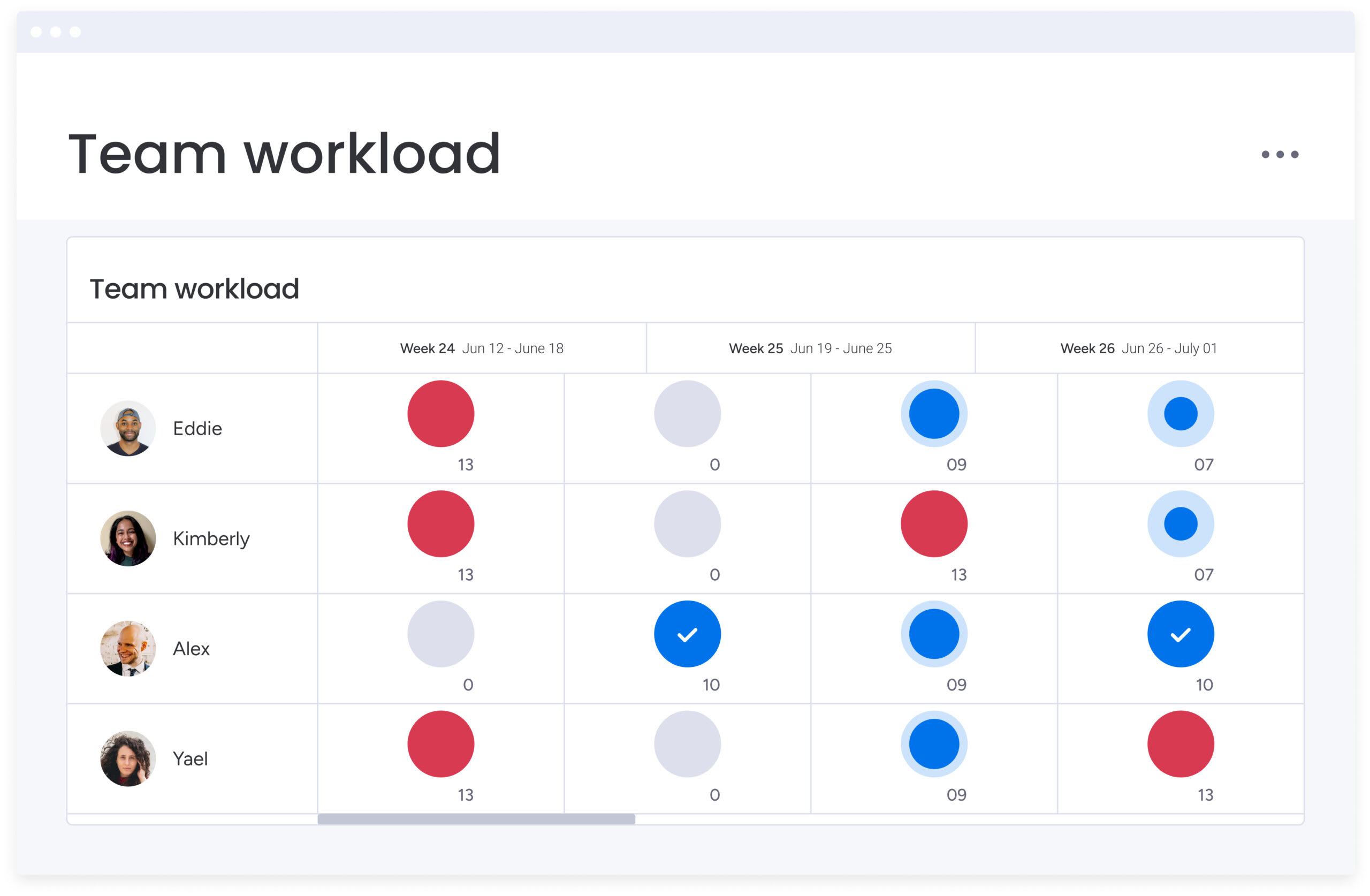
Before you start allocating resources, you need to develop an understanding of your project scope and what resources are available. That means figuring out exactly what tasks are on the docket and the range of resources you’ll need to complete them. Take different factors into consideration when cross-referencing those requirements against what’s currently available to you, such as:
- Skills, capacity, and experience of team members
- Resource availability (i.e., making sure there’s no overlap with other projects)
- Milestones and timeline for the project
After assessing the situation, you’ll be able to develop a budget and project timeline and evaluate your human resource management to make sure your team will be able to cope with the project.
Step 3: Forecast additional resource requirements
After assessing the resources currently at your disposal, start to plan for the resources you may still need to acquire. To do this, you need to determine the resources you need for each task, so you’ll also need to have a strong grasp of your project’s tasks and the timeline and effort needed for each.
Remember that at this stage, you’re just making estimations on what you’ll need based on data from previous projects. However, to make your estimations more accurate, you can rely on a work management platform like monday work management that integrates intelligent AI tools to build resource forecasts based on previous project trends. These forecasts can be used to make a more reliable list of tangible and non-tangible resources for your future projects.
Step 4: Allocate your resources
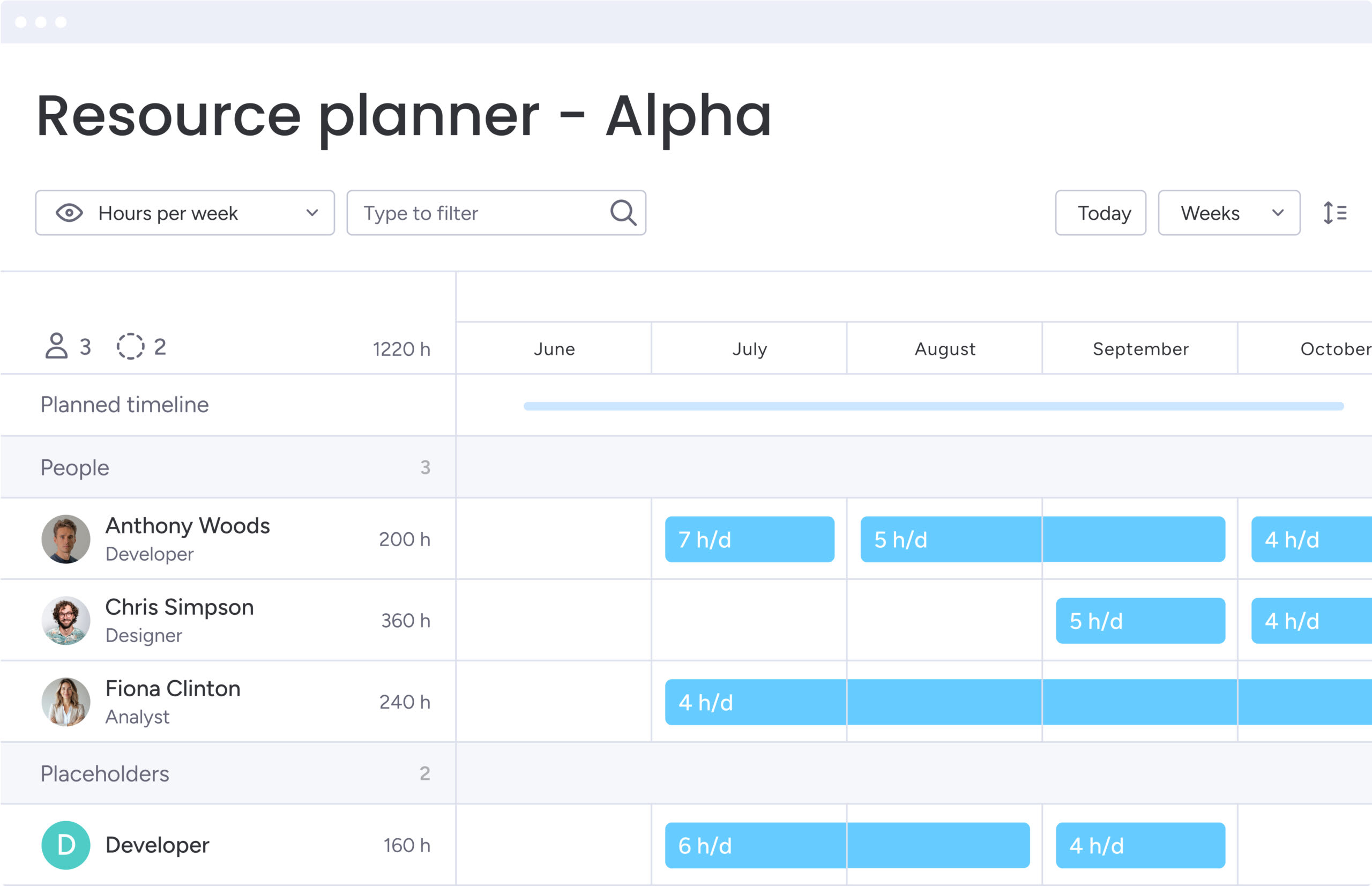
Next, you can begin to allocate the right resources to the right tasks and build out your project schedule and timeline. Start assigning resources one task at a time, noting where resources may overlap so that you can create accurate task dependencies.
The resource allocation process is all about assigning and scheduling resources to tasks or individuals, and then deploying those project resources wherever required. If you’re working with loads of resources, this is where a solution like monday work management really comes in handy to visualize workloads and automate resource allocation.
Step 5: Monitor and review your resources
Just because you’ve allocated your resources doesn’t mean you’re done managing. Resource planning is all about optimizing efficiencies and alleviating heavy workloads. As a result, the resource planning process requires you to constantly monitor and assess the utilization of resources.
You might find there are places where you’ve over-allocated or under-allocated some resources. Make sure to build time into your plan to assess resource use and make adjustments as needed. As much as possible given budget constraints, it’s also a good idea to factor in some extra resources, such as additional time, additional skilled employees, or backup tools as a risk mitigation plan.
By following these steps, you’ll be able to create an effective resource plan that will outline how your project team uses resources to maximize efficiency and avoid turning your team into a statistic.
Get startedWhat to include in a resource plan: 6 core elements
There are a few key elements that make up a successful resource plan. Make sure each one is accounted for when planning and allocating resources.
- Resource requirements: Outline all the human and non-human resources needed for your project. This includes team members with specific roles or skill sets, as well as tools, software, facilities, and materials.
- Resource availability and scheduling: Define when each resource will be available, accounting for working hours, time off, and overlaps with other projects that could impact timelines.
- Resource allocation: Assign resources to specific tasks or project phases. Include timelines, dependencies, and expected workloads to avoid confusion or bottlenecks.
- Resource costs: Document estimated costs for every resource, such as hourly rates, license fees, or equipment rentals. Then, break down the total project budget by resource type or project phase.
- Risk and contingency planning: Identify risks that could lead to shortages, delays, or overuse of key resources. Be sure to create contingency plans like time buffers or backup personnel to minimize disruption.
- Resource monitoring and reporting: Include a system for tracking resource use throughout the project. This might involve KPIs, dashboards, or reports that help project managers stay on top of resource utilization and adjust plans as needed.
Once you’ve outlined these key elements, the next step is refining your approach with proven best practices to ensure your plan runs smoothly in real time.
Best practices for resource planning
To make your resource plan even more effective, there are some best practices you can implement to help smooth things along.
Prioritize limited and shared resources
Start by identifying the resources in highest demand, whether that’s specialized team members, a shared budget, or key tools. Then build your plan around their availability. If multiple projects are competing for the same resource, consider setting up a prioritization system (like a scoring framework) to ensure the most critical work gets first access.
Align stakeholders early in the planning process
Effective resource planning isn’t successful in a vacuum. Be sure to involve cross-functional teams, department leads, and other key stakeholders early on to align on goals, timelines, and shared resource needs. The more upfront collaboration you have, the less of a chance there will be miscommunications or costly conflicts down the line.
Use time tracking to improve future plans
Time-tracking tools can reveal how resources are actually being used rather than just how you thought they would be used. Over time, this data helps you make smarter estimates, spot bottlenecks, and plan more accurately for future projects.
Build flexibility into your resource plan
Even the best resource plans will face changes. Instead of reacting later, plan for flexibility from the start by including time buffers, backup personnel, and scalable tools so you can adapt quickly if priorities shift or delays occur.
Document resource planning processes
Keep detailed reports, documentation, and plans on resource allocation. Documentation serves multiple purposes, such as keeping stakeholders in the loop, ensuring proper resource utilization, and informing future resource plans.
Common resource planning challenges and solutions
Even the most well-structured resource plans can run into obstacles. From missed deadlines to team burnout, small missteps in planning can have big consequences. Below, we’ve outlined some of the most common challenges teams face along with practical ways to solve them through better visibility, communication, and proactive planning.
| Challenge | What happens | How to fix it |
|---|---|---|
| Underestimating resource requirements | Delays, missed milestones, budget overruns | Use historical data, forecasting tools, and stakeholder input |
| Ignoring resource availability | Scheduling conflicts, stalled work, missed deadlines | Maintain a real-time availability calendar |
| Overloading team members | Fatigue, burnout, reduced quality and productivity | Monitor workloads and balance resource distribution |
| Lack of communication | Misaligned expectations, missed tasks, team friction | Share resource plans openly and hold regular check-ins |
| Failing to update the resource plan | Outdated priorities, unmanaged risks, poor decisions | Treat the plan as a living document and review regularly |
| Misaligning skill sets with tasks | Rework, delays, and low-quality output | Match resources to tasks based on skills and experience |
Top features to look for in a resource planning tool
There are tons of PMO resource management tools out there that promise to make it easier to streamline resource planning. Choosing the right resource planning tools can make the process a lot simpler, but only if you know how software can help and what features to look for.
Look for a resource management platform that can:
- Automate stages of resource planning with intelligent features and AI
- Make it easier to manage team workloads visually to avoid overloading employees
- Generate data, reports, and insights to make smarter resource choices
- Alert managers to resource shortages, overlap, or irregularities
- Forecast resource requirements from project to project with relevant data
- Automate scheduling and match resources to tasks based on availability and skill set
- Improve collaboration and communication with shared work views and notifications
- Track costs and spending against project budgets
Now that you have a better idea of how software can benefit resource allocation, let’s take a closer look at a specific resource management solution: monday work management.
How monday work management can help you automate resource planning
If you want to stretch your resources so that you can reach your huge list of tasks without burning out your team, you’re going to need a platform that’s flexible and easy to integrate with your existing processes and systems. This is where monday work management enters the picture.
Not only does monday work management offer a resource management template complete with boards set up to make it easy to automate resource planning, allocate assets, and avoid conflicts, but it’s packed with AI-powered tools to help you avoid manual resource management. Additionally, monday work management features an incredibly intuitive and easy-to-use platform, so you can focus more on resource planning and less on fitting your workflows to your software.
Now, let’s dive deeper into some of the monday work management features that make it a standout resource planning platform.
AI automation blocks for instant resource allocation

With monday work management, you can access AI blocks to make resource allocation simpler. Instantly implement AI-powered automation to assign resources, tasks, and categorize them according to their priority levels.
Intelligent reporting and forecasting
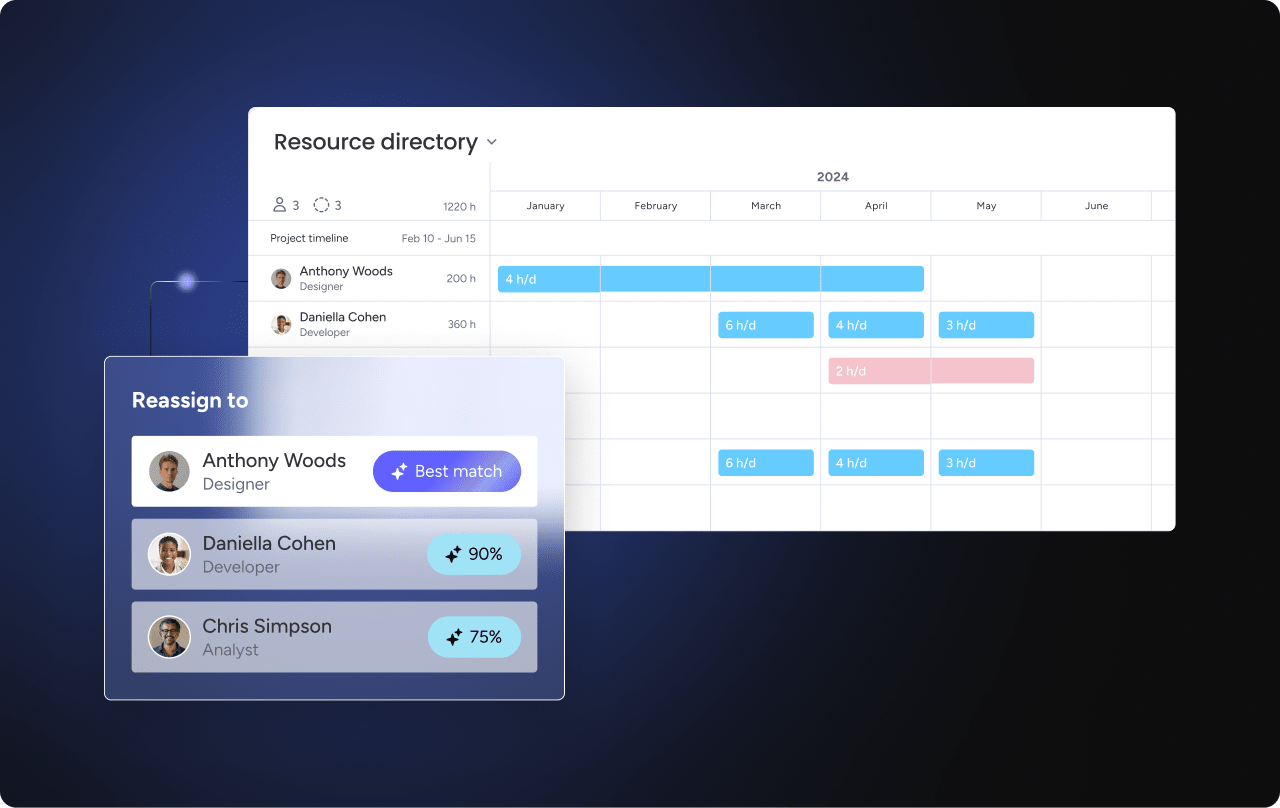
Thanks to built-in AI, monday work management makes it easy for teams to get real-time visibility into insights and reports based on trends and historical data. Access forecasts to understand how to best allocate resources on future projects and get smart AI suggestions to make resource planning even more seamless.
Avoid overloading employees thanks to AI agents
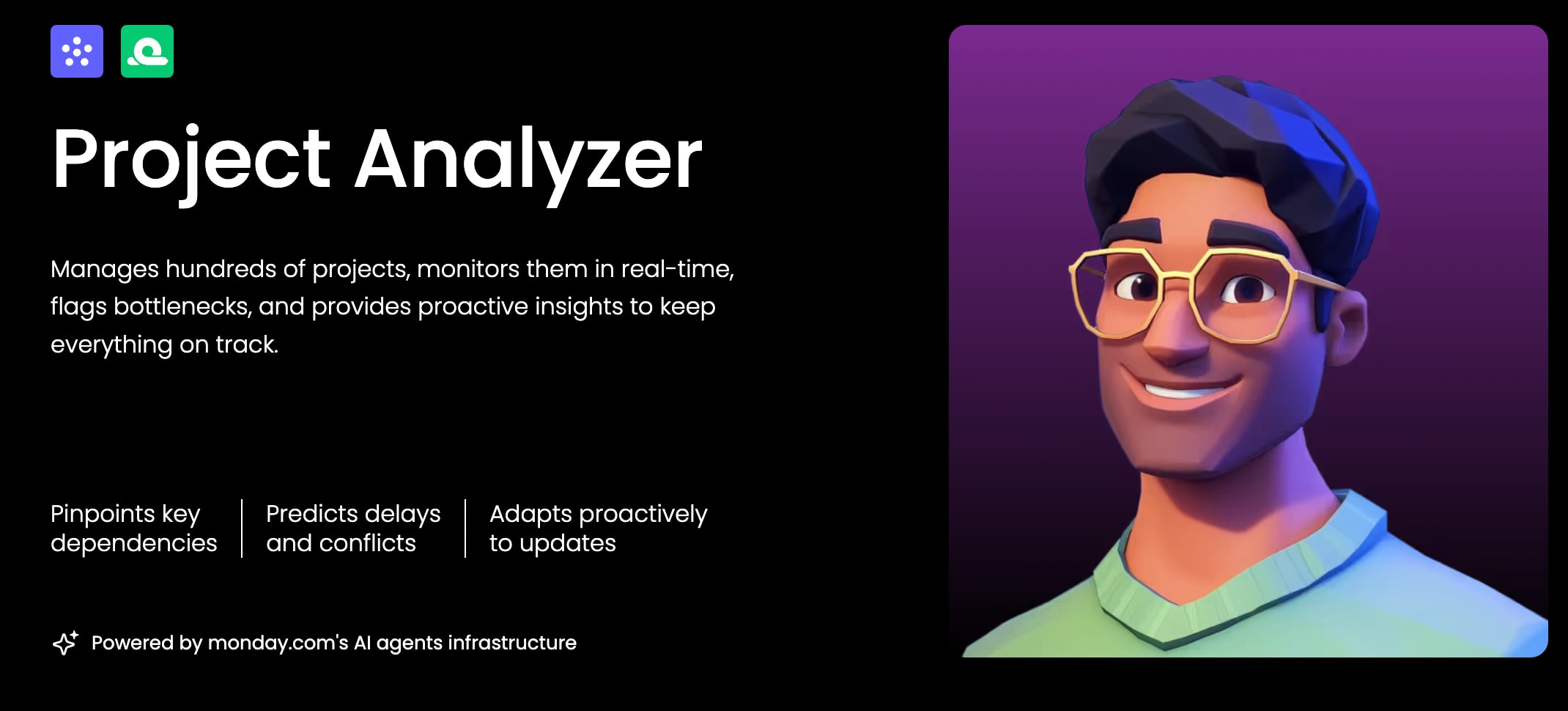
AI agents can provide team members with recommendations for how to proceed with tasks and maximize resources, helping them work more efficiently. With AI taking over manual tasks such as follow-ups, reminders, and content generation, managers can avoid overloading their team with too much work.
Turn resource planning into your competitive advantage
At the end of the day, resource planning is critical if you want your project to succeed. Resource planning will help you find that perfect balance, and monday work management will get you there.
Whether you’re looking for resource planning for a small team or startup, or you want an Enterprise Resource Planning (ERP) tool, monday work management can scale to meet a variety of needs. With hundreds of integrations, dozens of work visualization styles, resource planning templates, and AI features to tie it all together with smart automation, the platform was designed to help you efficiently resource your projects and get the job done.
Get startedFAQs
What is the purpose of a resource plan?
The purpose of a resource plan is to secure the right people, tools, and materials at the right time to complete a project successfully. It helps manage workloads, prevent bottlenecks, and keep projects on schedule and within budget.
What are the 3 stages or elements of resource planning?
Some resource planning models describe 3 stages (planning, scheduling, and monitoring), or 5 steps (assessing resources, forecasting needs, identifying gaps, developing strategies, and implementation). We've chosen to break those concepts into 5 actionable steps tailored for project teams, from defining scope to allocating and reviewing resources in real time.
How do you build a resource plan?
Start by identifying the tasks involved in the project, then determine what resources, human and non-human, are needed to complete them. Estimate availability, allocate resources to tasks, and create a resource schedule that reflects dependencies, workloads, and timelines.
How do you use monday work management for resource planning?
With monday work management, you can create boards to track tasks, assign team members, and set deadlines. Use workload views, time tracking, and custom dashboards to monitor capacity and ensure resources are distributed efficiently across projects. You can also use AI-powered automation to tackle resource allocation, forecasting, reporting, and more.
 Get started
Get started


